GIGABYTE G1.Sniper Z87 Review
by Ian Cutress on February 24, 2014 2:00 PM EST- Posted in
- Motherboards
- Intel
- Gigabyte
Real World CPU Benchmarks
Readers of our motherboard review section will have noted the trend in modern motherboards to implement a form of MultiCore Enhancement / Acceleration / Turbo (read our report here) on their motherboards. This does several things – better benchmark results at stock settings (not entirely needed if overclocking is an end-user goal), at the expense of heat and temperature, but also gives in essence an automatic overclock which may be against what the user wants. Our testing methodology is ‘out-of-the-box’, with the latest public BIOS installed and XMP enabled, and thus subject to the whims of this feature. It is ultimately up to the motherboard manufacturer to take this risk – and manufacturers taking risks in the setup is something they do on every product (think C-state settings, USB priority, DPC Latency / monitoring priority, memory subtimings at JEDEC). Processor speed change is part of that risk which is clearly visible, and ultimately if no overclocking is planned, some motherboards will affect how fast that shiny new processor goes and can be an important factor in the purchase.
For reference, the GIGABYTE G1.Sniper Z87 does use MultiCore Turbo in its default operation.
Rendering – Adobe After Effects CS6: link
Published by Adobe, After Effects is a digital motion graphics, visual effects and compositing software package used in the post-production process of filmmaking and television production. For our benchmark we downloaded a common scene in use on the AE forums for benchmarks and placed it under our own circumstances for a repeatable benchmark. We generate 152 frames of the scene and present the time to do so based purely on CPU calculations.

Due to MCT, the effect on After Effects is a slight speed up, observable on the minute scale of our small test.
Compression – WinRAR 5.0.1: link
Our WinRAR test from 2013 is updated to the latest version of WinRAR at the start of 2014. We compress a set of 2867 files across 320 folders totaling 1.52 GB in size – 95% of these files are small typical website files, and the rest (90% of the size) are small 30 second 720p videos.
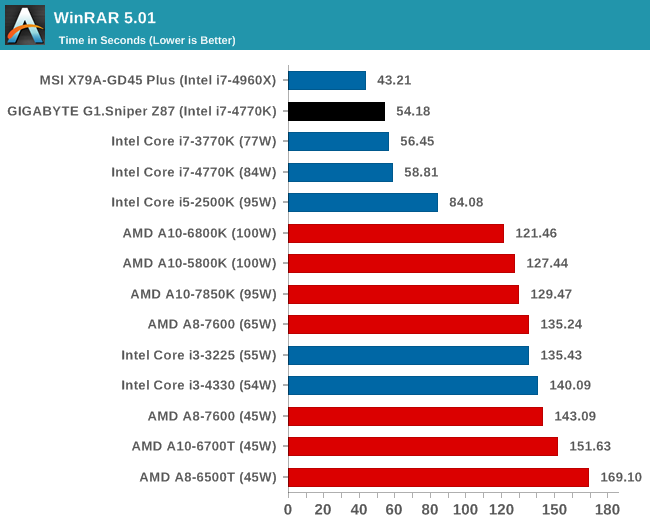
Similarly with WinRAR, there is a small speed up vs. a non-MCT enabled motherboard.
Image Manipulation – FastStone Image Viewer 4.9: link
Similarly to WinRAR, the FastStone test us updated for 2014 to the latest version. FastStone is the program I use to perform quick or bulk actions on images, such as resizing, adjusting for color and cropping. In our test we take a series of 170 images in various sizes and formats and convert them all into 640x480 .gif files, maintaining the aspect ratio. FastStone does not use multithreading for this test, and thus single threaded performance is often the winner.
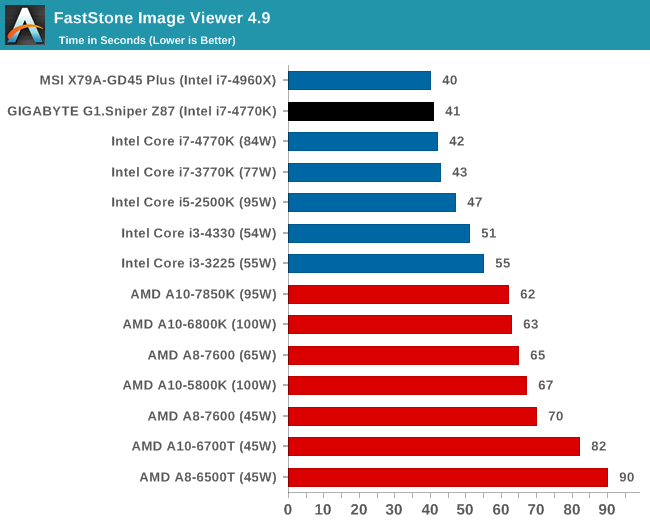
Video Conversion – Xilisoft Video Converter 7: link
The XVC test I normally do is updated to the full version of the software, and this time a different test as well. Here we take two different videos: a double UHD (3840x4320) clip of 10 minutes and a 640x266 DVD rip of a 2h20 film and convert both to iPod suitable formats. The reasoning here is simple – when frames are small enough to fit into memory, the algorithm has more chance to apply work between threads and process the video quicker. Results shown are in seconds and time taken to encode.

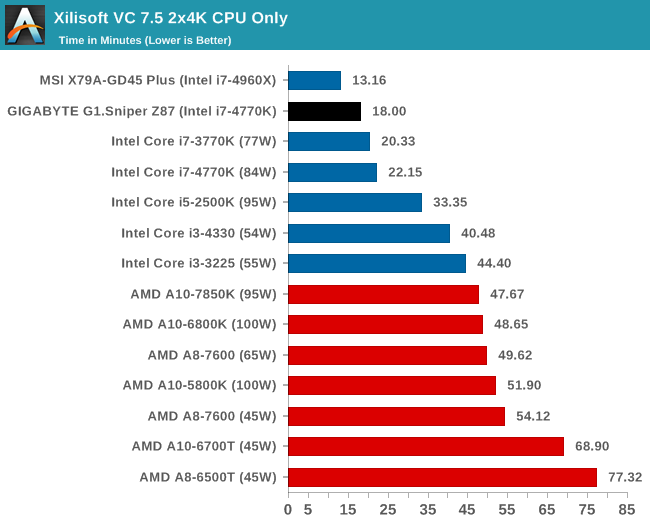
Video Conversion – Handbrake v0.9.9: link
Handbrake is a media conversion tool that was initially designed to help DVD ISOs and Video CDs into more common video formats. The principle today is still the same, primarily as an output for H.264 + AAC/MP3 audio within an MKV container. In our test we use the same videos as in the Xilisoft test, and results are given in frames per second.
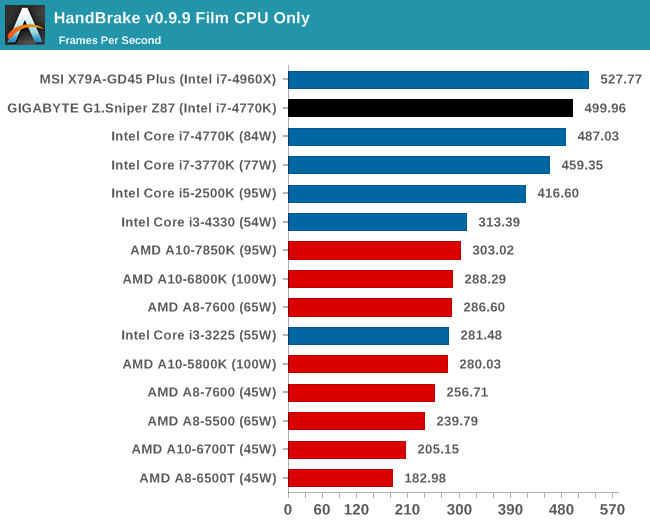
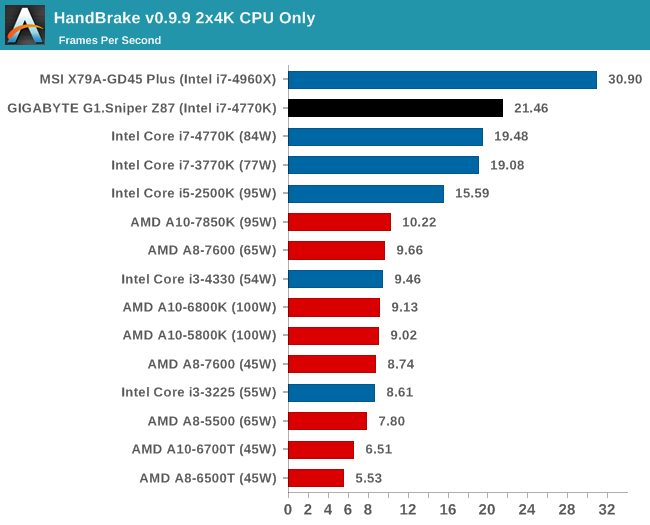
Rendering – PovRay 3.7: link
The Persistence of Vision RayTracer, or PovRay, is a freeware package for as the name suggests, ray tracing. It is a pure renderer, rather than modeling software, but the latest beta version contains a handy benchmark for stressing all processing threads on a platform. We have been using this test in motherboard reviews to test memory stability at various CPU speeds to good effect – if it passes the test, the IMC in the CPU is stable for a given CPU speed. As a CPU test, it runs for approximately 2-3 minutes on high end platforms.











36 Comments
View All Comments
nos024 - Wednesday, February 26, 2014 - link
Wow, PCI slots on a high-end Z87? Where was this when I wanted PCI slots?Jay77 - Wednesday, February 26, 2014 - link
Have I mentioned how much I hate PCI slots? They were a waste of space and resources 5 years ago and they are an insult now. A PCIe 2.0 x2 or x4 slot is going to be real handy in the next couple of years (3-way crossfire, not so much). Pissing away lanes on PCI is just stupid at this point.Frolictoo - Sunday, March 2, 2014 - link
Overall, this is a good motherboard. However, I wish they would include a second LAN port, one based the various Intel options. I have always built multi-boot systems and the ports do not behave the same under different OSs while the gaming must go on.RAYBOYD44 - Monday, March 3, 2014 - link
my Aunty Violet got a new Volvo XC60 SUV by work part-time using a laptop.Antronman - Saturday, March 29, 2014 - link
I thought PCI slots were extinct?trebor darnoc - Monday, April 28, 2014 - link
I have such a stupid question. . . I love this review and ended up buying the board. But now I have a question about the F_PANEL (Front Panel Header) connections. On page 27 in the manual, there is a diagram for the F_PANEL. But it shows 2 different 'Power LED' locations! There is a 2 pin Power LED possibility at one corner and a 3 pin option at the opposite corner (of the F Panel) . The Power LED wires from my case (Corsair 450D) are 2 individual little connectors marked Power LED (one + and one -). All the other wires from the case are little 'doubles' with 2 wires each, clearly marked. If you look at that page in the G1.Sniper Z87 manual you will see one is labeled 'PWR_LED' and the other 'PLED', but each one of those has a little box describing that connection as 'Power LED' just like the cables say. Can I use either one? I thought the case wires might be split for a reason, which led me to considering the 3 pin grouping (connecting the outer pins and leaving the middle one bare)? ? ? ? ?